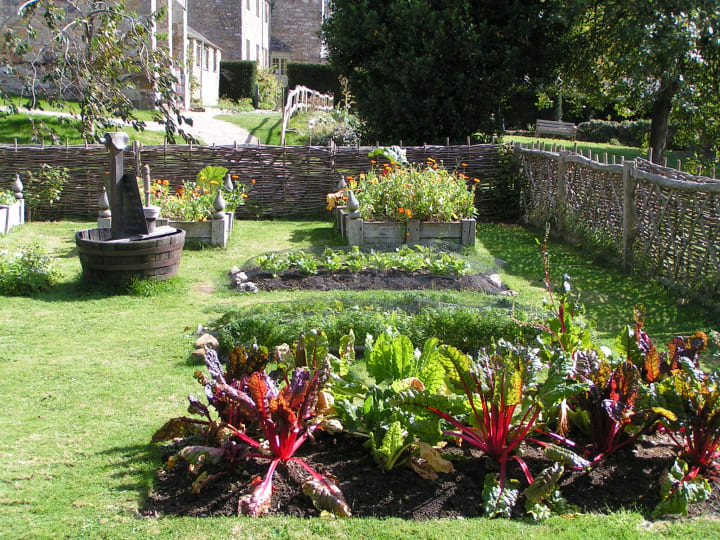Children Learn About Tudor Plants, Traditions and Gardening
Mole Control, Purple Carrots, and Herbal Remedies

Trerice is an impressive National Trust property in Cornwall, England, dating back to the Tudor period and the reign of Queen Elizabeth I. The liveliness and cultural significance of the times is reflected in the visitor experience today, as occasional displays of Tudor music echo around the quiet surroundings of the country estate. Volunteers recreate the atmosphere of times past, by encouraging visitors to dress up, play Elizabethan games, and get into role play!
In its heyday, the property would almost certainly have had a kitchen garden to supply fresh produce to the manor. It was lost over time, so in 2003 the National Trust decided to reintroduce some vegetable plots as part of its educational programme.
Creating a Kitchen Garden

A modest kitchen garden around the back of the house, was created in 2003 by 36 children, aged nine to eleven, who turned the former paddock and pig sty into a fenced kitchen garden full of purple carrots, turnips, marrows, leeks and other appealing produce.
With the help of the gardeners from the National Trust, and some experts in Tudor living, the children selected a garden design from a 16th century book called The Gardener’s Labyrinth, by Thomas Hill. It was the first book ever written in English on landscape gardening, and it gained popularity at a time when noblemen were buying country houses with big gardens.
Meet the Gardener
I met the gardener in charge, Wella, who gave me a tour of the plots: “The children come back on a regular basis to tend the garden. They do sowing and harvesting, and the gardening staff do some weeding in between visits” he explained.
Among the crops in the main beds were rhubarb, chard, salad greens, kale, and carrots and outside the fenced perimeter was an abundance of herbs, figs, gooseberry and fruit bushes.
Mole Control
Displayed on a poster in the learning room was a highly controversial approach to mole control: 1. catch mole, 2. drop in pot, 3. pour sulphur over it, 4. set the pot alight. I hoped the children didn’t take this seriously!
Wella explained: “We have an actor who plays a Tudor gardener by the name of William Woad and he comes to Trerice a couple of times a year and talks to the children about the ways they used to garden. He tells them about the gruesome things the Tudors did and the methods they used, including the way that they caught and killed moles.”
A second approach to mole control simply involved frightening them away with garlic, onion and leeks “unless they kill them with their strong flavour!” I liked that one better.
Cooking with the crops
The children never had a moment to get bored — when they weren’t tending to the plots, they were busy making apple crumbles or creating musical instruments and lanterns for the annual Tudor wassailing ceremony in January.
Traditionally wassailing was intended to awake the cider apple trees and scare away evil spirits, ensuring a good harvest in the Autumn.
“Every year, children attend a horn making workshop just before the wassail” said Wella, “and some of them attend the evening ceremony which is the twelfth night after new year. It takes place in the orchard and we usually have local Morris dancers who help out with the singing and percussion. There is singing and then the children make lots of noise banging drums and blowing the horns that they have made.”
The Orchard
The sun shone upon us in the orchard as we walked among a multitude of apple trees, fig bushes, and herb plots.

I asked Wella how the school partnership originated. “We got in touch with St Newlyn East Primary School, with an idea to bring Elizabethan history to life by offering opportunities for the children to learn about the past in an exciting and memorable way,” he explained.
“Every autumn, the school takes part in an apple-crumble competition where National Trust properties compete in a time-constrained event to bake an apple crumble. Each property finds a school group to do it, and the one that cooks their crumble the fastest wins. Our school consistently comes an annoying second, with the first place going to different winners every time. It’s very frustrating for the children!”
I looked at a display about the garden project — a montage of children’s thoughts and drawings: “History is not dry, dusty or boring, but it is fun, loud, dirty and sometimes a bit rude! Gardening is great — it’s better than school!”
The enthusiasm continued: “Trerice is going to buy more raised plots and a ‘great squirt’ which will water the plants! We will make bat boxes and grow new and exciting vegetables. We have helped by planting bulbs at Trerice, and made lanterns and crum horns for the wassail.”

Pest control and purple carrots
The display boards made interesting reading, if a little alarming in places! One of the more novel methods of pest control read: “I sprayed my crops with a mixture of dog muck and old wee and that’s guaranteed to scare them [badgers] away and protect my purple carrots.”
Purple carrots were popular in Elizabethan England and this inspired the children’s decision to grow them in the kitchen garden at Trerice. Turnips were also popular and the Tudors used them to cure ‘painful wee’ — the natural diuretic effect of turnip was considered to provide some relief to people suffering from cystitis. Turnip juice was used to help people with kidney stones, and foxglove leaves reportedly had a healing effect when they were bound to fresh wounds.
A new era
In 2013, the kitchen garden project came to an end and the gardens were transformed again — an Elizabethan Knot garden was created. It was inspired by a decorative plaster ceiling in the Great Chamber of the manor house. With seasonal flowers year round, it continues to provide a fabulous educational experience, exploring Elizabethan history, for young and old alike.
For more information visit www.nationaltrust.org.uk/trerice






Comments
There are no comments for this story
Be the first to respond and start the conversation.